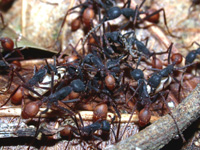

Section 2: What is the relationship between ant-following birds and army ants?
BACKGROUND
Ant-following birds clearly benefit from army ants by capturing prey they otherwise would not. The effect of the birds on the army ants is less obvious. Wrege et al. (2005) conducted an experiment designed to quantify the effect of ant-following birds on the army ant Eciton burchellii in Panama. Their experiment consisted of paired 10-minute trials replicated on 18 army ant swarms (see Section 1 for more details). For each swarm, observers first counted the number of ant aggregations (indications of the capture of large prey, see photo) during 10 minutes when ant-following birds (6.1 ± 2.2 birds per swarm, mean ± 1 SD) were present.

Army ant workers (Eciton burchellii) clustered around a captured insect.
Photo by Alex Wild, used with permission.
They then chased away the birds by waving their arms or, if a bird was extremely persistent, by squirting it with a water gun. They then again counted the number of aggregations during the next 10 minutes. Thus, their experiment had a control treatment (birds present) and exclusion treatment (birds absent). Unfortunately, they could not randomize the order of these treatments (that is, they always did the control treatment first) because some birds would not return quickly after being chased away.